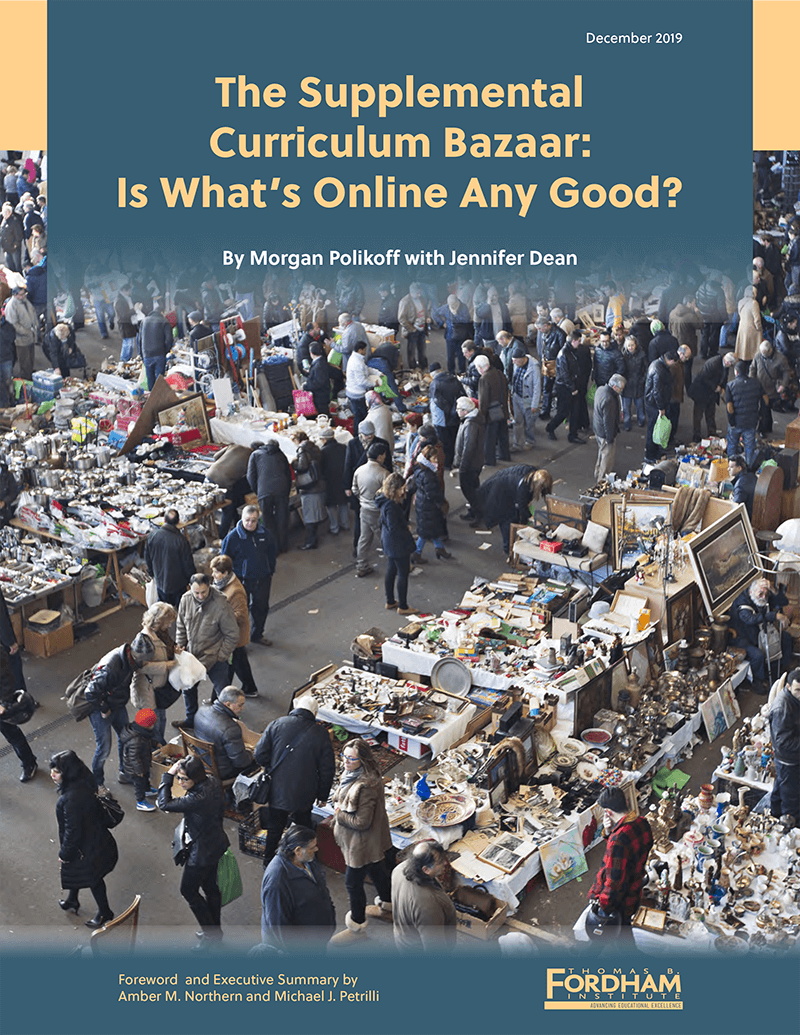
Almost all American teachers supplement their core curriculum (if they even have one) with materials they gather from the internet. National surveys show that supplementation is a growing phenomenon, and that many teachers use supplementary materials in large proportions of their lessons. While we know that supplementation is widespread, and we have a good handle on what websites teachers rely on, we don’t really know what kinds of materials teachers seek out and whether they are any good.
To shed some light, the Fordham Institute recently asked me and co-author Jennifer Dean to study the quality of more than 300 of the most-downloaded high school English language arts (ELA) materials on three popular websites: TeachersPayTeachers, ShareMyLesson, and ReadWriteThink. We built a rubric to measure the quality of the materials along multiple dimensions, and we recruited ELA experts to help us evaluate the materials. The report, “The Supplemental Curriculum Bazaar: Is What’s Online Any Good?” is published today. Here’s what we learned.
First, our reviewers found the texts referenced in the lessons were generally high-quality texts and worth reading (though many of them were still below grade level). They also found that the materials were mostly free from errors, well organized, and reasonably attractive.
Unfortunately, our reviewers felt the weaknesses of the materials far outweighed the positives. On a 0-3 scale, 64% of materials were rated a 0 or a 1, meaning teachers “should not” or “probably should not” use them. Just 1-7% of the materials, depending on the website, earned the top score of 3, indicating they are “exceptional and/or highly likely to contribute to a quality curriculum.” What were the main issues detected? Here are a few common culprits:
Alignment is weak. Almost all of the materials we reviewed claim alignment to very large numbers of standards—sometimes dozens or more are tagged for a single lesson or unit. But our reviewers often felt that the materials only aligned to some of the tagged standards, meaning teachers have to do their alignment homework in selecting a material—they cannot simply accept what the materials’ authors claim about alignment.
Assessments fall short. Reviewers examined the student assessments that were included in the lessons and units along several dimensions. They found these assessments often did an inadequate job of covering the core content. Just a bare majority of materials (51%) included scoring rubrics of any kind to help teachers evaluate student work (and many of those rubrics were deemed low quality).
Materials are not cognitively demanding and don’t build content knowledge. Reviewers found that the vast majority of the tasks were focused on lower-level skills, with very few emphasizing advanced skills like critical thinking and solving real-world problems. We also asked reviewers to examine the extent to which multi-day units introduced and sequenced knowledge in a way that allowed students to build their understanding of a topic. A majority of materials (58 percent) “not at all” or only “weakly” built students’ content knowledge in this way.
Materials do an especially poor job offering teachers support for teaching diverse learners. Out of all the dimensions on which our reviewers evaluated the materials, some of the worst scores pertained to supporting diverse learners. Just 14% of materials offered teachers any guidance on differentiating instruction for high or low performing students, English language learners, or other student groups (yes, we know that’s hard to do but that’s no reason to ignore such needs). Less than 1% of materials were rated as having “extensive” differentiation supports. Reviewers also examined both the choice of authors and the texts themselves relative to their representation of cultural diversity, with a focus on race/ethnicity, gender, and culture/national origin. Two-thirds of materials did not include diverse authors (i.e., women, people of color, or authors from nondominant cultures) or cover culturally diverse topics (i.e., the experiences of women, people of color, or authors from nondominant cultures) at all. While some may argue that only full-blown curriculum can be expected to reflect such diversity, our reviewers felt strongly that the underrepresentation of diverse voices in these materials was a problem.
We view these findings as rather grim, especially given the ubiquity of teachers’ use of these kinds of materials. That said, we take a few lessons away from this work, which we hope educators and policymakers heed.
First, and most obviously, there is a need to improve the quality of supplemental materials along these and other dimensions. There is also a need to help curate what already exists, which could be done by the websites themselves; by users, including district curriculum leaders; or by other experts (in fact, we think the best approach would probably include both expert reviews and user reviews). Of course, teachers can still have the freedom to use good materials, but more curation would help ensure a minimum level of quality in the classroom.
Second, alignment and assessment quality are clear areas where more attention is needed. Teachers should be able to trust the purported alignment ratings on these websites, and that materials will provide quality assessments with which to evaluate student learning. Teachers are simply too strapped to put in all of the time needed to make these materials comprehensive, challenging, and well aligned.
Third, there is a particular need for materials that represent the cultural diversity of our students. More than half our K-12 students are nonwhite, but a scant proportion of the materials included readings by nonwhite authors or about nonwhite characters. Similarly, gender and national origin are important sources of diversity in our classrooms that are not adequately represented in the materials we reviewed.
It’s clear that teacher-sourced, online supplemental materials, while immensely popular, have a long way to go in terms of quality, and we hope that content creators at these and other websites will see these findings as a clarion call to improve. Still, we are not trying to second-guess teachers. They are finding something valuable in these online materials; interviews indicate that it’s their engagement and help with differentiation that are most useful. Those are important, but we need to be careful not to give up on providing coherence, alignment, and rigor in return.
Morgan Polikoff is an Associate Professor at the Rossier School of Education at USC.



